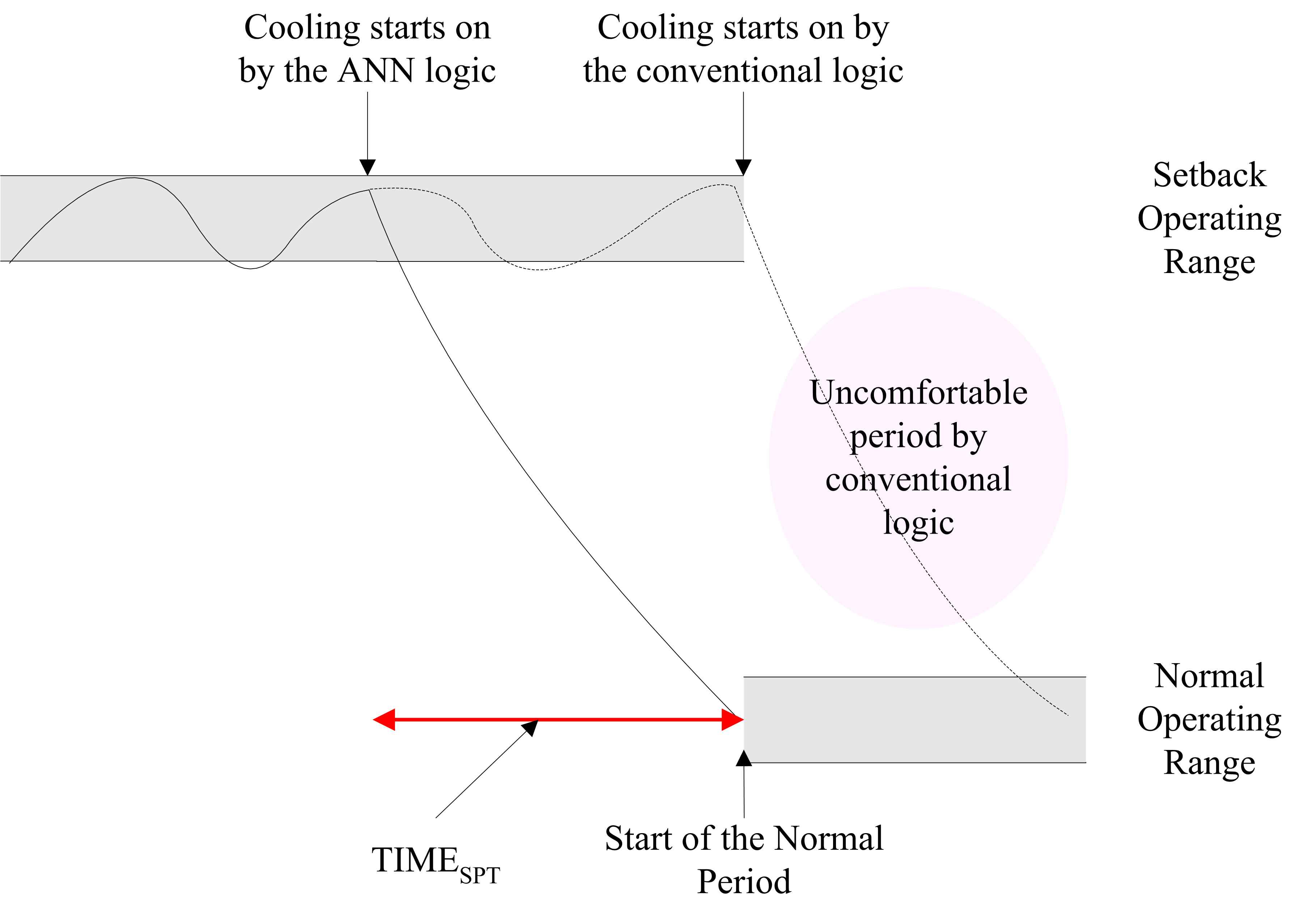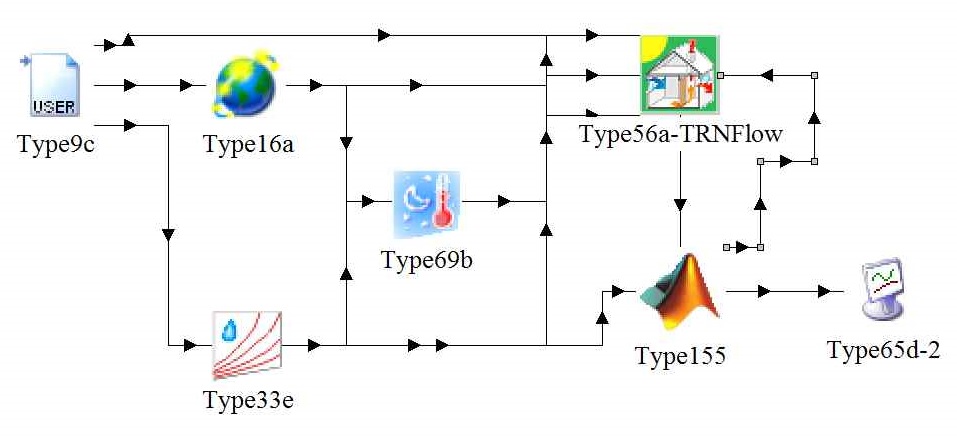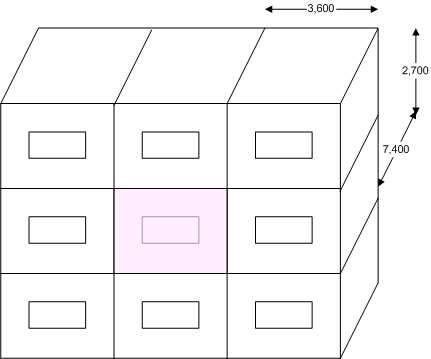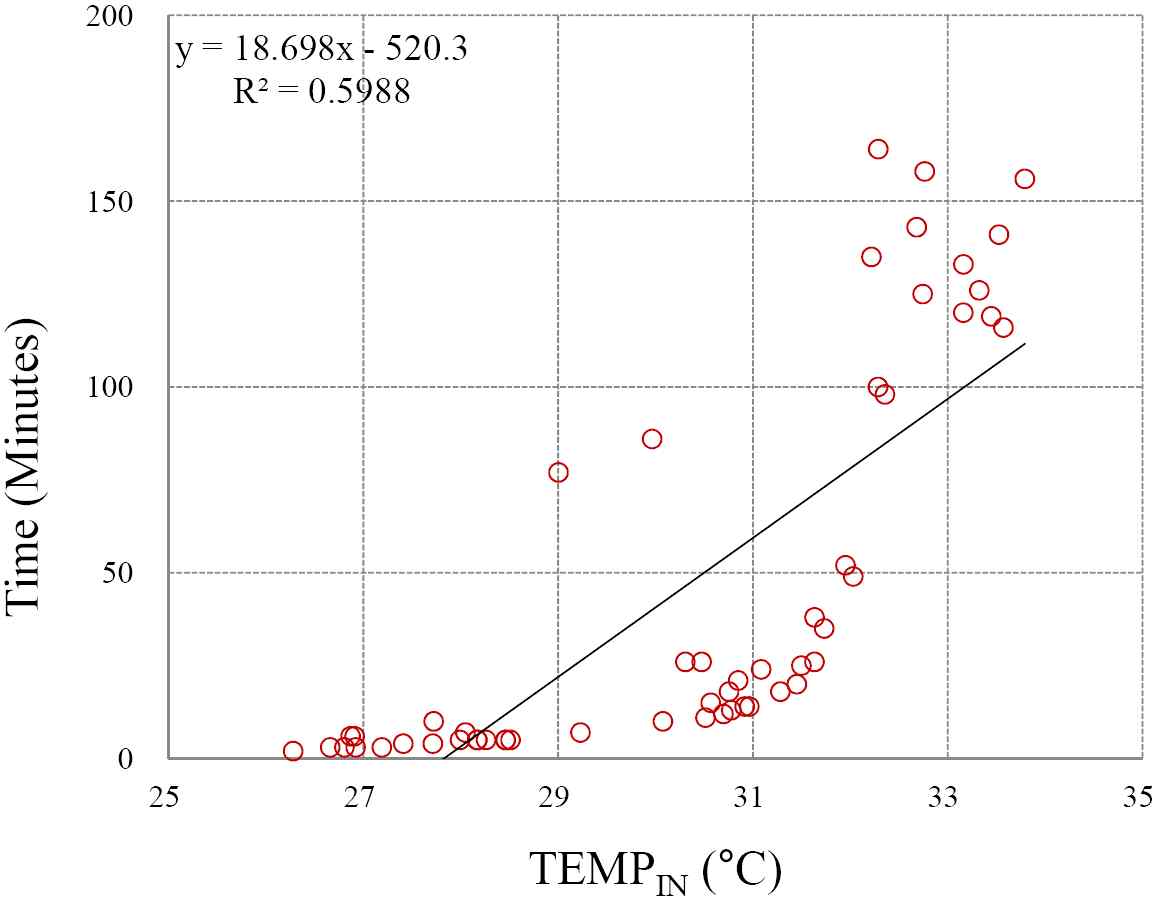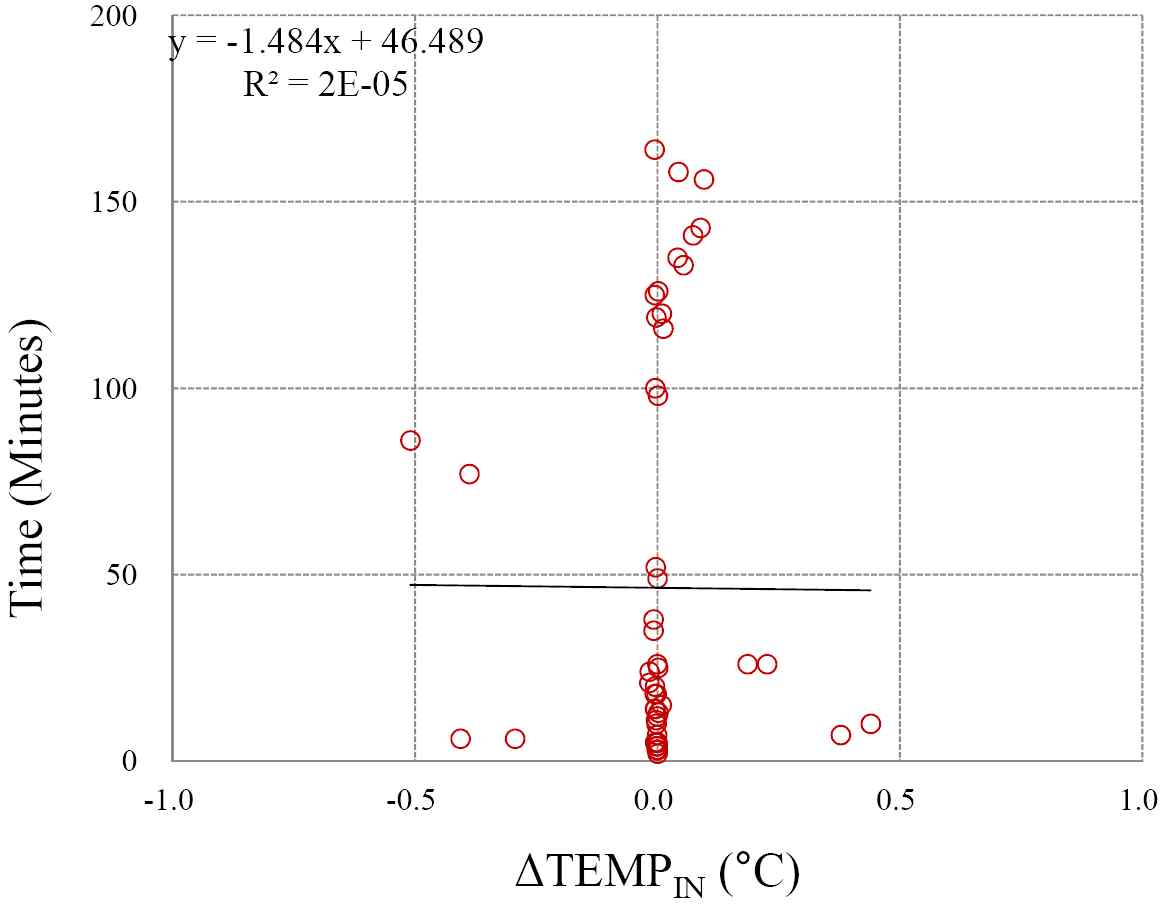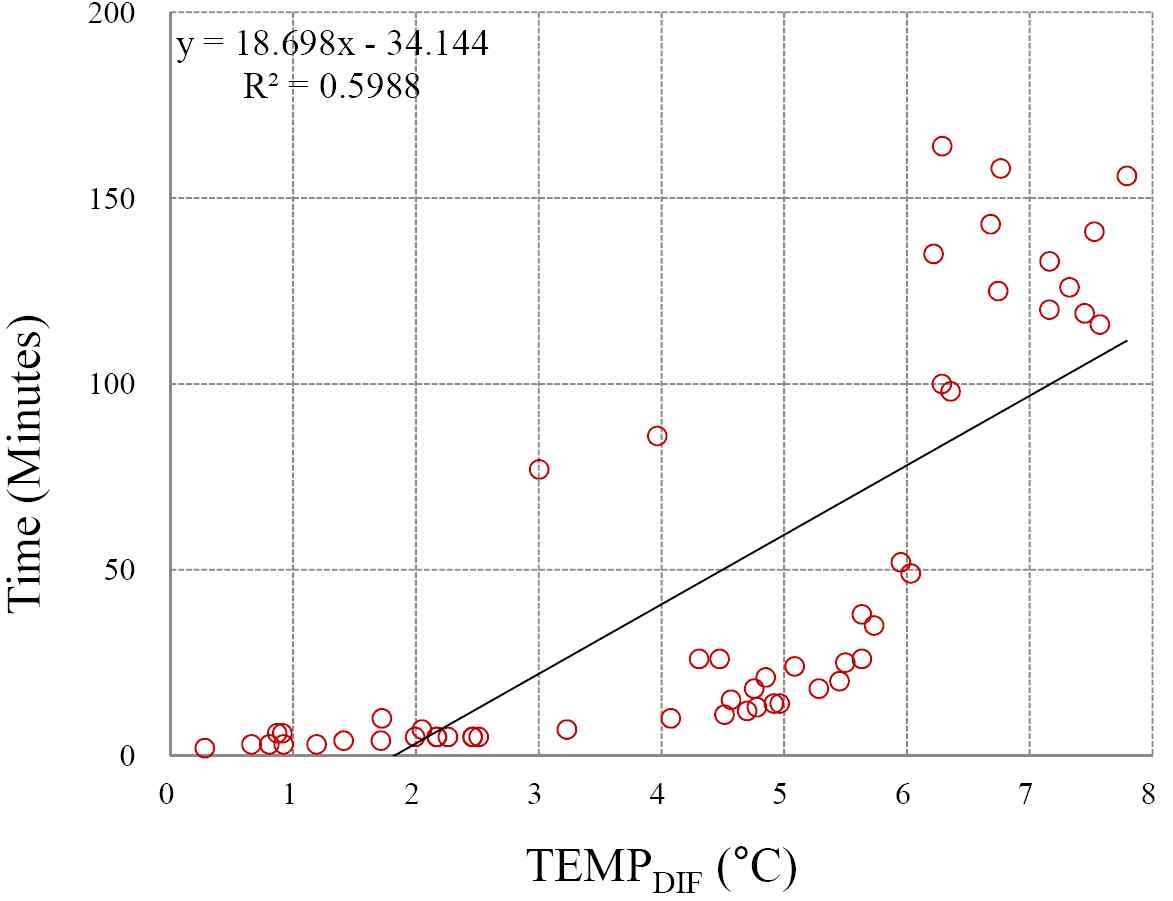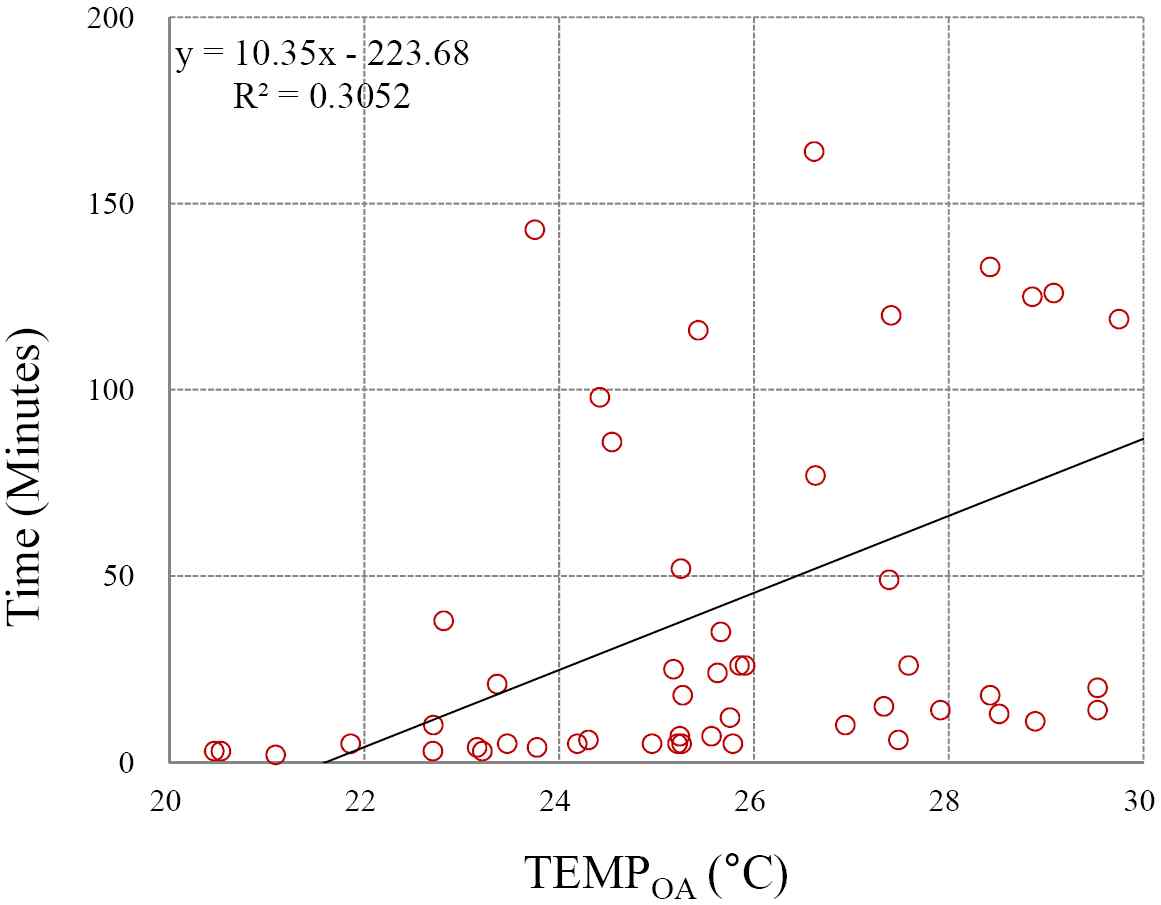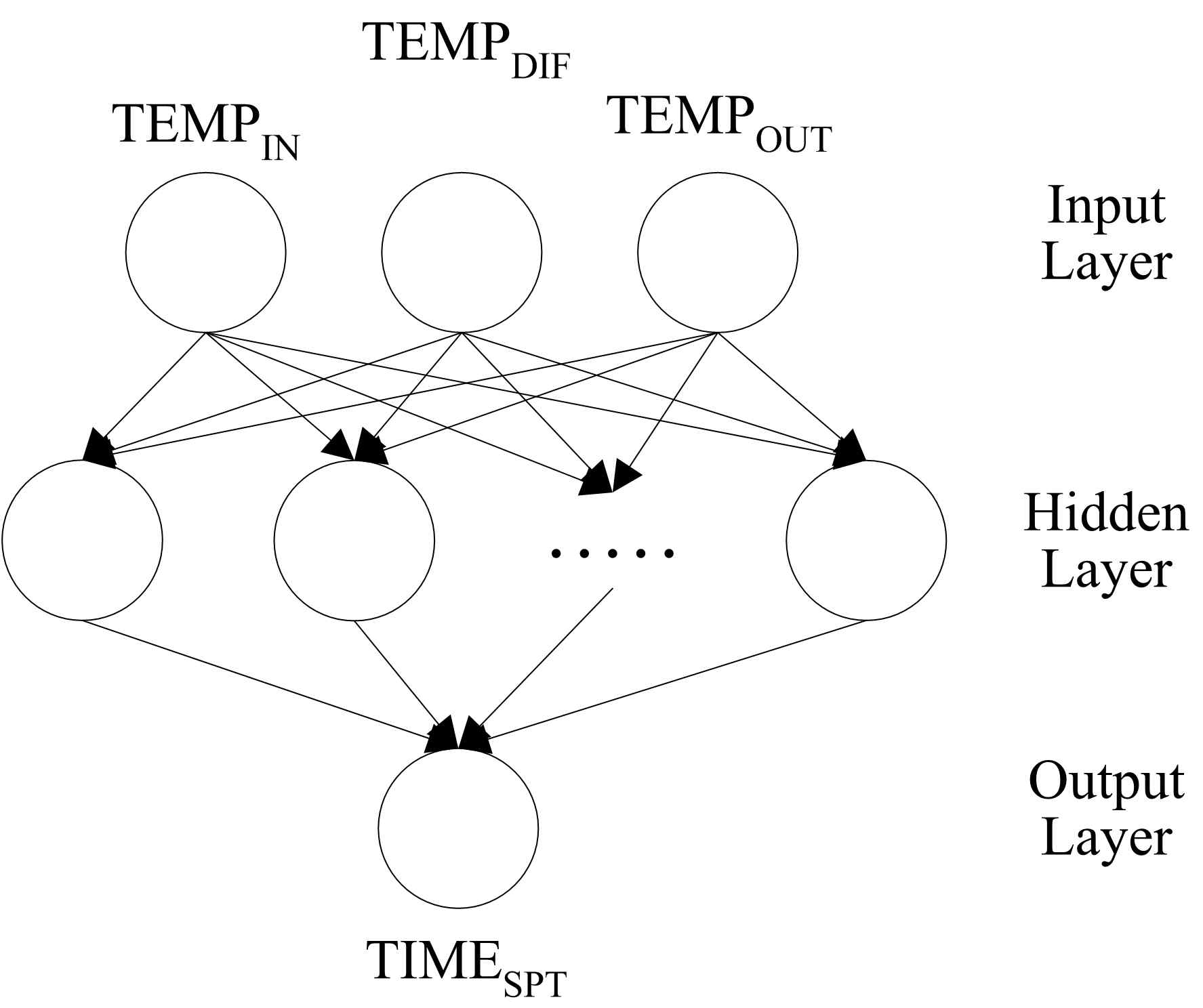
숙박시설 냉방 시스템의 최적 작동 시점 예측 모델 개발을 위한 입력 변수 선정
ⓒ Copyright Korea Institute of Ecological Architecture and Environment
Abstract
This study aimed at finding the optimal input variables of the artificial neural network-based predictive model for the optimal controls of the indoor temperature environment. By applying the optimal input variables to the predictive model, the required time for restoring the current indoor temperature during the setback period to the normal setpoint temperature can be more precisely calculated for the cooling season. The precise prediction results will support the advanced operation of the cooling system to condition the indoor temperature comfortably in a more energy-efficient manner.
Two major steps employing the numerical computer simulation method were conducted for developing an ANN model and finding the optimal input variables. In the first process, the initial ANN model was intuitively determined to have input neurons that seemed to have a relationship with the output neuron. The second process was conducted for finding the statistical relationship between the initial input variables and output variable.
Based on the statistical analysis, the optimal input variables were determined.
Keywords:
Optimal Controls, Predictive Model, Input Variables, Thermal Environment, Accommodations키워드:
최적제어, 예측모델, 입력변수, 열환경, 숙박시설1. 서론
닫혀진 공간으로 이루어진 건물의 주된 목적은 재실자에게 편안하고 쾌적한 환경을 제공하는 것이다. 실내환경의 질(indoor environmental quality, IEQ)는 이러한 건물의 목적과 밀접한 관계를 가지고 있으며, 특히 실내 열 환경의 질(thermal quality, TQ)는 실내환경의 질을 좌우하는 가장 중요한 요소 중 하나이다.
열적으로 쾌적한 공간 상의 재실자들은 주의력 향상, 생산성 향상, 결과물 및 서비스의 수준 향상 뿐만 아니라 결석율과 실수 및 사고의 감소, 호흡기 질환 등 건강에 해로운 상황의 감소 등의 긍정적 효과를 가질 수 있다.1) 이러한 긍정적인 효과는 냉난방 및 감가습 시스템 등의 적절한 제어를 통하여 확보될 수 있다.
적절한 시스템의 제어는 쾌적한 열 환경 조성 외에도 건물의 에너지 성능을 향상시키는 효과를 제공할 수 있으며, 향상된 건물에 에너지 성능은 건물에 의한 환경 영향의 감소와 관련이 있다. 열환경 조성을 위한 에너지를 절감시킴으로써 지구 온난화와 직접적 관련이 있는 탄소배출량을 감축시킬 수 있다.1)
호텔 건물과 같은 숙박업소의 경우 열 환경 제어의 측면에서 특이한 성격을 보여준다. 우선, 숙박업소는 각 실은 일반적으로 주간에 비어있으며 야간에 재실자들이 사용하는 특징을 가진다. 그러므로, 야간의 쾌적한 열 환경 조성이 주 목적이 된다.
또한, 재실자들은 언제나 쾌적한 열 환경을 제공받기를 기대하고 있는 반면 사용되고 있는 냉난방 에너지에 대한 관심을 가지고 있지 않다. 그들은 일정한 금액의 숙박료를 지불하며 사용되는 냉난방에너지에 대한 추가의 금액을 지불하지 않는다. 그렇게 때문에 냉난방 시스템이 과도하게 작동될 가능성이 있으며, 재실 기간 중 부적절한 설정 온도 혹은 비 재실 기간 중 불필요한 시스템 작동이 그 예로 볼 수 있다.
숙박시설 열 환경 제어 시스템의 적절한 제어를 위하여 적극적인 관리가 요구되어진다. 쾌적한 열 환경 조성 뿐만 아니라 에너지 성능 향상을 위하여 전문가시스템(expert system)의 도입을 통한최적의 설정 온도 혹은 셋백온도가 적용될 필요성이 있다. 더불어 재실기간의 시작 시점에 쾌적한 열 환경 조건 제공을 위하여 최적의 셋백기간 종료 시점을 결정할 수 있는 제어법이 적용되어야 한다. 최적 종료 시점을 적용함으로써 재실자가 실로 돌아올 시점에 쾌적한 조건을 제공할 수 있다.
Moon and Kim은 실내 열 환경의 쾌적성과 에너지 성능 향상을 위하여 <그림 1>과 같은 제어 로직의 틀을 제시하였다.2) 로직은 다섯 단계의 과정으로 구성된다. 첫 번째 단계는 물리적 상태(Physical conditions)와 관련되는 것으로써 실내외온도와 같은 요소의 상태를 감지하고 제어반으로 전송하기 위한 것이다. 두 번째 단계는 쾌적 영역을 설정하기 위한 것으로 이 영역에 따라 냉난방 시스템이 작동하게 된다. 두 번째 단계와 유사한 세 번째 단계는 에너지와 관련되어 사용자 혹은 로직에 의하여 셋백 온도와 기간을 설정하는 단계이다. 이러한 단계에서의 설정조건에 따라 네 번째 단계에서 냉난방시스템의 작동 상태를 결정하게 되며, 최종 다섯 번째 단계에서 시스템이 작동하게 된다.
본 연구의 목적은 여름철 셋백온도(setback temperature)로 설정된 비재실 기간 중의 실내온도가 냉방시스템 작동 후 정상상태 설정온도(setpoint temperature)로 돌아가기 위한 필요시간(TIMESPT)을 예측할 수 있는 인공신경망 모델을 개발하는 것이다. 개발된 모델은 <그림 1>의 네 번째 단계에 적용되어 냉방시스템을 미리 가동함으로써 정상상태 시작 시점의 실내 온도가 쾌적하게 유지될 수 있도록 한다. 또한, 최적의 가동 시작 순간 예측, 적용함으로써 지나치게 일찍 가동함으로써 발생할 수 있는 냉방 에너지 낭비를 감소시킬 수 있을 것으로 예상된다. 즉, 개발된 모델을 적용함으로써 열 쾌적성과 에너지 성능을 동시에 향상시킬 수 있을 것으로 기대된다.
2. 예측모델 개발
Warren McCulloch와 Walter Pitts에 의하여 개발된 인공신경망(artificial neural network, ANN) 이론은 인간의 신경전달구조와 학습방법을 도입한 계산모델이다. 인공신경망 모델을 크게 두 가지의 과정을 진행한다. 첫 번째는 feed-forward 과정으로써 일련의 입력변수와 숨겨진층의 변수, 그리고 각 변수간 관계(connectivity, weight) 및 전이함수(transfer function)를 이용하여 출력값을 계산하는 것이다. 두 번째 과정은 back-propagation 과정으로써 모델에서 계산된 출력값과 실제값과의 차이(error)를 이용하여 변수간 관계를 수정하여 보다 정확한 계산이 가능하도록 하는 단계이다.1)
이러한 두 과정에 의하여 시스템의 예측(predictive) 및 적응(adaptive)제어가 가능해진다. 예를 들어, 인공신경망모델에 의하여 예측된 건물의 미래 온도는 보다 쾌적한 열 환경 조건 형성을 위하여 사용되어질 수 있다. 또한, 새롭게 획득되는 관련 자료를 이용하여 모델을 지속적으로 학습함으로써 신경망 모델은 보다 안정적이고 정확한 결과값을 도출할 수 있게 된다.1)
기존의 연구결과 인공신경망에 기반한 제어모델이 회귀모델 혹은 PID (proportional-integral-derivative) 등 수학적 모델이 비하여 성능면에서 우수한 것으로 밝혀졌다.2) 건물 열 환경 제어를 위하여 적용될 경우 감소된 과열, 과냉을 바탕으로 보다 쾌적하고 에너지 효율적인 냉난방 시스템 작동이 가능한 것으로 나타났다.3-9) 특히, 난방시스템의 최적 작동을 위한 인공신경망 모델을 보다 섬세한 제어를 가능하게 하였다.5,6) 또한, 실내 온도뿐만 아니라 습도 및 PMV 제어에 있어서도 우수한 결과를 나타냈다.1,2,10,8)
더불어, 인공신경망 모델은 다양한 형태의 열 환경 제어 시스템에 성공적으로 적용되고 있다. 주거용 수식 복사난방 혹은 바닥난방의 예측제어를 위하여 사용되고 있으며11-13), 압축식 냉동기의 증발기 작동이나 흡수식냉동기의 제어에도 유용한 것으로 밝혀졌다.14,15) 또한, 지열히트펌프의 성적계수(coefficient of performance, COP)의 예측에도 적용되었다.16-18) 이러한 기존의 연구결과는 진보된 열 환경제어를 위한 인공신경망 모델의 가능성을 뒷받침한다.
본 연구에서는 기존의 연구 결과를 바탕으로 여름철 셋백온도로 설정된 비재실 기간 중의 실내온도가 냉방시스템 작동 후 정상상태 설정온도로 돌아가기 위한 필요시간(TIMESPT)을 예측할 수 있는 인공신경망 모델을 개발하였다. 예를 들어, 셋백 기간 중 실내 온도가 28.0°C이고 재실 기간 중 정상 설정온도가 24.5°C일 경우, 필요시간 TIMESPT는 실내온도를 28.0°C부터 24.5°C까지 하강시키기 위하여 요구되어지는 냉방시스템 작동시간이다. 계산된 필요시간은 추후 제어로직에 적용되어 냉방시스템의 선제적 작동을 실시하게 된다.
<그림 2>는 개발된 예측 모델을 적용한 제어로직의 효과를 개념적으로 보여준다. 전통적 로직 및 예측제어로직 모두 셋백 기간 중 실내 온도는 셋백된 설정 온도에 의하여 유지된다. 하지만, 셋백 기간이 종료될 시점 두 로직은 제어법에서 차이를 보인다. 일반적으로 전통적 제어로직은 재실기간이 시작되는 시점에 정상 설정온도를 적용하여 냉방시스템을 작동하게 된다. 이 경우, 실내온도는 일정 기간 동안 쾌적영역보다 높게 형성되어 쾌적하지 못한 열 환경을 조성하게 된다.
이러한 상황을 개선시키기 위하여 전통적 로직에서는 재실기산 시작에 앞서 일정 시간 전에 정상 설정 온도를 적용하여 냉방시스템을 작동하게 된다. 적용된 일정 시간은 재실자 혹은 건물 관리자의 정확치 않은 경험 혹은 직관에 의하여 결정되게 된다. 이 경우 여전히 비쾌적한 기간이 존재할 수 있을 뿐만 아니라 지나치게 일찍 시작된 냉방으로 인하여 에너지 낭비로 이어질 수 있다.
반면, 예측제어로직에서는 이 기간 중 매 제어 사이클마다 예측모델을 사용하여 TIMESPT을 계산한다. 만일 계산된 TIMESPT와 현재시간의 합이 재실시작 시점의 시간을 넘어설 경우 냉방 시스템은 정상 설정온도를 적용하여 작동을 미리 시작하게 된다. 이렇게 미리 작동을 시작함으로써 재실이 시작될 시점에는 쾌적한 온도 환경을 제공받게 된다. 또한, 최적의 시작 시점이 적용됨으로써 불필요한 냉방에너지 소비를 감소시킬 수 있다. 즉, 최적제어법 적용 시 열 쾌적 환경 조성 및 에너지 성능 측면에서 우수한 결과를 예상할 수 있다.
이러한 예측모델의 개발을 위하여 본 연구에서는 두 가지 과정을 실시하였다. 첫 번째는 초기 모델을 개발하는 단계로써 일련의 입력 변수와 기존의 연구에서 제시된 숨겨진 층 및 뉴런 수, 그리고 변수간 관계를 적용하였다. 두 번째 단계는 입력변수와 출력변수간의 상관관계 분석을 실시하여 관계성이 높은 입력변수를 도출한다. 최종모델은 상관성이 높은 변수를 입력변수로 하도록 개선되었다.
2.1. 초기 모델 개발
초기 모델의 구조 및 구성은 <그림 3>과 <표 1>에 정리되어 있다. 모델의 개발은 MATLAB (matrix laboratory)19) 소프트웨어을 이용하여 진행되었다. 입력변수로는 실내온도(TEMPIN), 실내 온도변화량(ΔTEMPIN), 설정온도와의 차이(TEMPDIF), 그리고 외기온도(TEMPOUT) 등 네 가지로 설정하였다. 각 입력변수의 범위는 0~50, -10~10, 0~20, 그리고 -20~40°C 이며, <식 1>을 이용하여 0에서 1사이의 값을 가지도록 치환되어 적용하였다.
| <식 1> |
초기 모델의 숨겨진 층의 수는 하나이고 숨겨진 층의 뉴런 수는 표에서 주어진 식에 의하여 9으로 결정되었다. 전이함수로는 tanget-sigmoid와 pure-linear법이 숨겨진 층의 뉴런과 출력층의 뉴런에 각각 적용되었다. 모델의 학습을 위하여 0.0-minute-goal, 1,000-times-epoch, 0.6-learning rate, 그리고 0.4-moment의 학습법이 사용되었다. 더불어, 45 세트의 학습데이터를 이용하여 학습을 실시하였으며, sliding-window 법을 적용하여 데이터를 새롭게 유지하였다. <표 2>는 구성된 학습데이터의 예를 나타낸다.
2.2. 최적 입력 변수 선정
최적 입력 변수를 선정하기 위하여 입력 변수와 출력 변수간의 상관관계 분석을 실사하였다. 개발된 모델을 TRNSYS (transient systems simulation)24) 소프트웨어에 적용 후 분석을 위한 데이터를 수집하였다. <그림 4>는 모델링의 결과를 보여준다.
데이터는 <그림 5>에서 보여지는 동일한 구조의 9개 실 중 중앙실로부터 획득되었다. 테스트 실의 위치, 크기, 외피단열성능, 적용 시스템, 실내 부하, 침기 부하 등이 <표 3>에 정리되어 있다.
3. 결과 분석
신경망모델의 입력변수와 출력변수간의 관계가 <그림 6-9>와 <표 4>에 각각 정리되어 있다. 입력변수를 독립변수(independent variables)로 가정한 상태에서 비표준계수(unstandardized coefficients)와 분산분석(analysis of variance, ANOVA)을 이용하여 상관관계를 분석하였다.
출력변수(TIMESPT)와 입력변수들(TEMPIN, ΔTEMPIN, TEMPDIF, TEMPOUT)간의 R2값은 각각 0.5988, 2e-5, 0.5988, 그리고 0.3052로 나타났다. 두 번째 입력변수(ΔTEMPIN)가 출력변수와 통계적 의미에서 유관성이 현저히 떨어지는 것으로 드러났다. 유의수준(significance)은 ΔTEMPIN,을 제외하고는 모두 0.001보다 적으므로 통계적 의미의 안정성을 나타내었다.
따라서, 개선된 인공신경망 모델은 기존의 네 가지 입력변수에서 한 가지를 제외한 세 가지 입력 변수를 가지도록 구성되었다. 그 결과는 <그림 10>에 나타나 있다. 기존의 모델에서 무의미한 입력 변수를 제거함으로써 결과값의 안정성과 더불어 계산의 용이성을 확보할 수 있을 것으로 기대된다.
4. 결론
본 연구에서는 여름철 셋백온도(setback temperature)로 설정된 비재실 기간 중의 실내온도가 냉방시스템 작동 후 정상상태 설정온도(setpoint temperature)로 돌아가기 위한 필요시간(TIMESPT)을 예측할 수 있는 인공신경망 모델을 개발하였다. 과정은 초기모델의 개발과 개선으로 이루어졌다.
MATLAB과 TRNSYS를 적용하여 대상 건물을 모델링하였으며, 대상 건물에서 획득된 자료를 이용하여 신경망 모델 입력변수와 출력변수간의 상관관계 분석을 실시하였다. 분석결과 기존의 네 가지 입력변수(TEMPIN, ΔTEMPIN, TEMPDIF, TEMPOUT) 중 상관 관계가 적은 ΔTEMPIN을 입력변수에서 제외시켰다.
개발된 모델을 제어로직에 적용할 경우 냉방시스템을 미리 가동함으로써 정상상태 시작 시점의 실내 온도가 쾌적하게 유지될 수 있을 것으로 기대된다. 또한, 최적의 가동 시작 순간 예측, 적용함으로써 지나치게 일찍 가동함으로써 발생할 수 있는 냉방 에너지 낭비를 감소시키는 효과를 가질 것이다. 즉, 개발된 모델을 적용함으로서 열 쾌적성과 에너지 성능을 동시에 향상시킬 수 있을 것으로 기대된다.
본 연구는 제어 로직에 적용될 인공신경망 모델의 개발과 개선에 초점이 맞추어져 있으며, 추후 연구를 통하여 개발된 모델을 적용한 제어 로직의 개발이 진행되어야 한다. 개발된 로직은 컴퓨터 시뮬레이션 또는 실제 건물 적용을 바탕으로 성능분석이 실시될 예정이며, 그 결과를 바탕으로 사용 가능성을 확보할 것이다.
Nomenclatures
| TEMPIN : | : indoor air temperature, °C |
| ΔTEMPIN : | : indoor air temperature change from the preceding control cycle’s indoor air temperature, °C |
| TEMPDIF : | : temperature difference from the setpoint temperature, °C |
| TEMPOUT : | : outdoor air temperature, °C |
| TIMESPT : | : predicted time required for changing from the current temperature to the setpoint temperature, minutes |
| Ni : | : number of neurons in the input layer |
| Nh : | : number of neurons in the hidden layer |
| No : | : number of neurons in the output layer |
| VALACT : | : actual value of each input variable |
| VALMIN : | : minimal value of each input variable |
| VALMAX : | : maximal value of each input variable |
Acknowledgments
본 논문은 2015년도 서일대학교 학술연구비에 의해 연구되었음.
Reference
- Jin Woo Moon, ANN-based model-free thermal controls for residential building, Ph.D. Dissertation, Taubman College of Architecture and Urban Planning, University of Michigan, Ann Arbor, (2009).
-
Jin Woo Moon, Sung Kwon Jung, Youngchul Kim, Seung-Hoon Han, Comparative study of artificial intelligence-based building thermal control methods – Application of fuzzy, adaptive neuro-fuzzy inference system, and artificial neural network, Applied Thermal Engineering, 31, (2011).
[https://doi.org/10.1016/j.applthermaleng.2011.04.006]

-
In-Ho Yang, Myoung-Souk Yeo, Kwang-Woo Kim, Application of artificial neural network to predict the optimal start time for heating system in building, Energy Conversion and Management, 44, (2003).
[https://doi.org/10.1016/s0196-8904(03)00044-x]

- In Ho Yang, Kwang-Woo Kim, Development of artificial neural network model for the prediction of descending time of room air temperature, International Journal of Air-Conditioning and Refrigeration, 12, (2000).
-
Abdulatif E. Ben-Nakhi, Mohamed A. Mahmoud, Energy conservation in buildings through efficient A/C control using neural networks, Applied Energy, 73, (2002).
[https://doi.org/10.1016/s0306-2619(02)00027-2]

-
Athanassios A. Argiriou, Ioannis Bellas-Velidis, Michael Kummert, Philippe Andre, A neural network controller for hydronic heating systems of solar buildings, Neural Network, 17, (2004).
[https://doi.org/10.1016/j.neunet.2003.07.001]

-
Athanassios A. Argiriou, Ioannis Bellas-Velidis, Balaras, CA, Development of a neural network heating controller for solar buildings, Neural Network, 13, (2000).
[https://doi.org/10.1016/S0893-6080(00)00057-5]

-
Jin Woo Moon, Performance of ANN-based predictive and adaptive thermal control methods for disturbances in and around residential buildings, Building and Environment, 48, (2011).
[https://doi.org/10.1016/j.buildenv.2011.06.005]

-
Jin Woo Moon, Seung-Hoon Han, A Comparative Study Between Thermostat/Hygrometer-Based Conventional and Artificial Neural Network-Based Predictive/Adaptive Thermal Controls in Residential Buildings, Journal of Asian Architecture and Building Engineering, 11, (2012).
[https://doi.org/10.3130/jaabe.11.169]

- Jin Woo Moon, Jong-Jin Kim, ANN-based thermal control methods for residential buildings, Building and Environment, 45, (2010).
-
Nicolas Morel, Manuel Bauer, Mario El-Khoury, Jens Krauss, NEUROBAT, a predictive and adaptive heating control system using artificial neural networks, International Journal of Solar Energy, 21, (2001).
[https://doi.org/10.1080/01425910108914370]

-
Jin-Young Lee, Myoung-Souk Yeo, Kwang-Woo Kim, Predictive control of the radiant floor heating system in apartment buildings, Journal of Asian Architecture and Building Engineering, 1, (2002).
[https://doi.org/10.3130/jaabe.1.105]

- Jin-Young Lee, In-Ho Yang, Seung-Yeong Song, Hway-Suh Kim, Kwang-Woo Kim, A study of the predictive control of the ondol system in apartments, In: International Building Performance Simulation Association, Kyoto (Japan), (1999).
-
Abbassi, A, L Bahar, Application of neural network for the modeling and control of evaporative condenser cooling load, Applied Thermal Engineering, 25, (2005).
[https://doi.org/10.1016/j.applthermaleng.2005.04.006]

- Chow, TT, Lin, Z, Song, CL, Zhang, GQ., Applying neural network and genetic algorithm in chiller system optimization, In: Seventh International IBPSA Conference, Rio de Janeiro (Brazil), (2001).
-
Esen, Hikmet, Inalli, Mustafa, Sengur, Abdulkadir, Esen, Mehmet, Forecasting of a ground-coupled heat pump performance using neural networks with statistical data weighting pre-processing, International Journal of Thermal Science, 47, (2008).
[https://doi.org/10.1016/j.ijthermalsci.2007.03.004]

-
Esen, Hikmet, Inalli, Mustafa, Sengur, Abdulkadir, Ense, Mehmet, Artificial neural networks and adaptive neuro-fuzzy assessments for ground-coupled heat pump system, Energy and Buildings, 40, (2008).
[https://doi.org/10.1016/j.enbuild.2007.10.002]

-
Esen, Hikmet, Inalli, Mustafa, Sengur, Abdulkadir, Esen, Mehmet, Performance prediction of a ground-coupled heat pump system using artificial neural networks, Expert Systems and Application, 35, (2008).
[https://doi.org/10.1016/j.eswa.2007.08.081]

- MathWorks, MATLAB 14, 26, (2012, May), Available from: http://www.mathworks.com/; (2012, May), p10-7.
- Datta, D, Tassou, SA, Marriott, D., Application of neural networks for the prediction of the energy consumption in a supermarket, In: Proceedings of CLIMA 2000 conference, Brussels (Belgium), (1997).
-
Jin Yang, Hugues Rivard, Radu Zmeureanu, On-line building energy prediction using adaptive artificial neural networks, Energy and Buildings, 37, (2005).
[https://doi.org/10.1016/j.enbuild.2005.02.005]

-
Jin Woo Moon, Ji-Hyun Lee, Yoon, Y, Sooyoung Kim, Determining optimum control of double skin envelope for indoor thermal environment based on artificial neural network, Energy and Buildings, 69, (2014).
[https://doi.org/10.1016/j.enbuild.2013.10.016]

-
Soteris A. Kalogirou, Milorad Bojic, Artificial neural networks for the prediction of the energy consumption of a passive solar building, Energy, 25, (2000).
[https://doi.org/10.1016/s0360-5442(99)00086-9]

- University of Wisconsin, TRNSYS16.1, (2013, Dec), Available from: http://sel.me.wisc.edu/trnsys/ (2013, Dec).
- Ministry of Land, Transport and Maritime Affairs, Design of environmental-friendly houses and guidelines for performance evaluation, Gwachon, Ministry of Land, Transport and Maritime Affairs of Korea, (2009).
- Alpine, Sizing estimator for heating & cooling equipment, (2013, Jun), http://www.alpinehomeair.com/view.cfm?objID=4A176770-C3EB-4E 97-AAED-C34B81D7AFED (2013, Jun).

